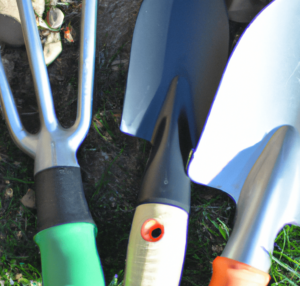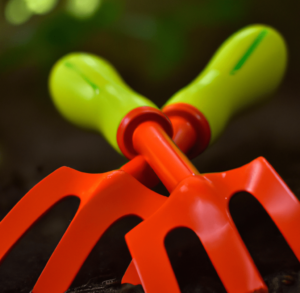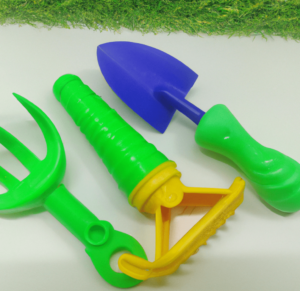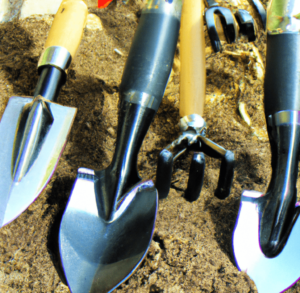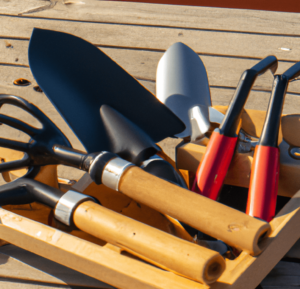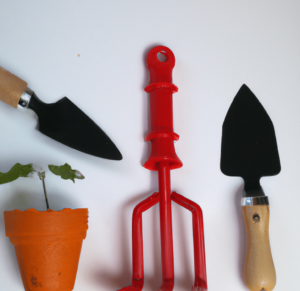Although gardening may be a calming and gratifying hobby, success depends on having the proper equipment for the job at hand. Varied jobs call for different instruments, from planting fragile seedlings to sifting through difficult clods. A trowel, a pruner, a hoe, and a rake are a few essential garden tools. Each item has been created to assist gardeners in carrying out particular duties more successfully and effectively. In this post, we’ll give a quick rundown of the different garden tools for specific tasks!
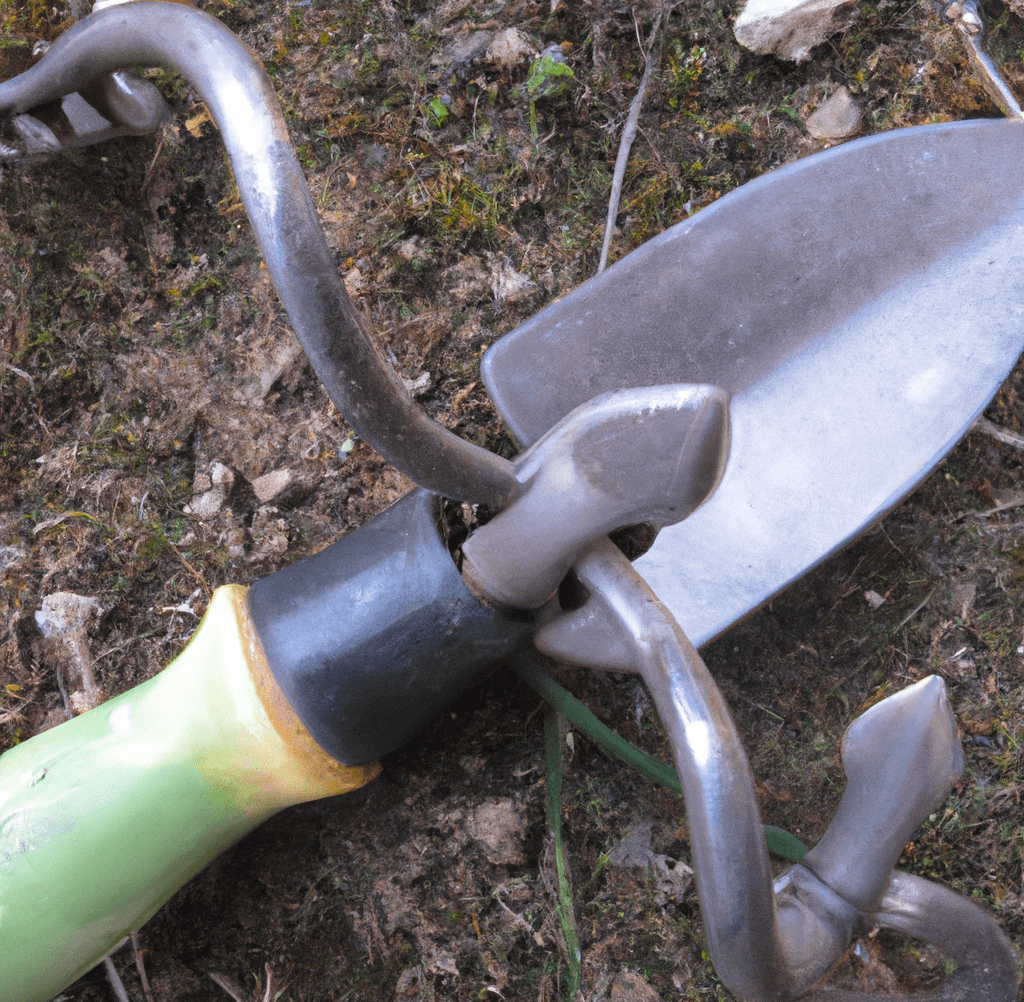
Pruning Tools
Every gardener needs to choose the right garden tools for their soil and climate which include ones for pruning. The act of cutting or trimming certain plant elements, such as branches, leaves, or roots, using garden equipment like pruning shears or saws, is referred to as pruning.
Pruning is done to manage a plant’s size and shape, encourage the growth of fruit or blooms, remove dead or diseased wood, and foster healthy growth. Plants, especially trees and shrubs, need to be pruned regularly to maintain their health and beauty. Pruning allows the plant to concentrate its efforts on developing new, healthy growth while reducing the likelihood of diseases and pests spreading through the removal of dead, damaged, or diseased wood. In order to prevent the plant from overgrowing or obstructing other plants or structures, pruning also helps shape the plant and regulate its size.
Types of Pruning Tools
When you’re learning about garden tools for specific tasks, here are the types of pruning tools on the market:
- Hand pruners: One of the most popular gardening tools, they are used for a range of trimming chores including thinning, shaping, and deadheading. Hand pruners exist in a variety of sizes and shapes, but they always function in the same way: they cut the plant by intersecting two sharp blades. Typically constructed of premium steel, they are built to be strong, long-lasting, and pleasant to use.
- Loppers: They’re shaped to make precise cuts through thick branches, like a large pair of scissors. Loppers can assist you with far larger tasks in your garden than pruning shears or a trowel can. Loppers are a necessary item if your garden is huge or you have a lot of plants. They can assist you in keeping your plants healthy and looking their best by making trimming more simpler and quicker. You can prune down overgrown trees or bushes that may be obstructing light or suffocating other plants with loppers. The fact that loppers are available in a variety of sizes and designs means you can pick the one that best suits your needs. While some loppers are more lightweight and suited for little operations, others are more lightweight and designed for cutting through thick branches. If you need to reach higher branches, extendable handles on some loppers can be useful.
- Shears: Shears are a common kind of gardening equipment used for shaping, trimming, and pruning plants. Having longer blades and greater leverage than scissors, they are similar to scissors and are therefore perfect for cutting through thicker branches and stems. Shears may be used on a variety of plants, which is one of its key advantages. Shears are adaptable enough to do the job whether you have delicate flowers or thick plants. They’re especially helpful for trimming back excessive stems or branches, which can encourage new development and maintain the orderly appearance of your plants. It’s crucial to think about the job you’ll be utilizing the shears for while you’re buying them. For instance, you should search for shears with longer blades and more leverage if you intend to cut through dense, woody branches. On the other hand, you’ll need a set of shears with thinner blades to clip delicate blossoms precisely without harming the plant.
How to Choose the Right Pruning Tools for Specific Tasks
As you’re learning about garden tools for specific tasks, here’s how to choose the right pruning tools:
- Use high-quality blades: You should search for blades that are manufactured of high-quality materials whether you’re using shears, loppers, or a pruning saw. High-carbon steel or stainless steel blades are often more resilient and can maintain their sharpness for longer.
- Think about the scope of the work: A trowel or a pair of pruning shears may be all you need to make small cuts or prune small plants. However, a lopper or a shovel can be necessary if you need to cut through larger branches or roots.
- Consider the soil: You’ll need a tool that can handle the job if you’re working with hefty clods or compacted soil. You may help break up the soil and get it ready for planting by using a robust shovel or a garden fork.
- Look for ergonomic pruning tools: Choosing equipment that’s pleasant to use is vital because pruning can be a physically hard chore. Look for equipment with soft handles and manageable weight.
You can choose the best pruning tools for your particular activities by taking these variables into account. Having the correct tools can make a huge difference in the health and aesthetics of your garden, whether you’re taking care of delicate blooms or battling stubborn, woody branches.
Digging Tools
The cultivation of soil, planting, and landscaping all need the use of fundamental gardening instruments called “digging tools.” It’s crucial to take into account the task you’ll be using the digging tools for when making your selection. A hand trowel can be all you need if you’re working in a raised bed or planting little flowers. However, you might want to get a shovel or spade if you’re working in a sizable garden or landscaping a sizable area. Digging implements are a necessary component of any gardener’s toolkit. There are several pieces of equipment available to help you plant, grow, and manage your garden, ranging from hand trowels to shovels. Therefore, make an investment in top-notch digging tools and start putting together the garden of your dreams.
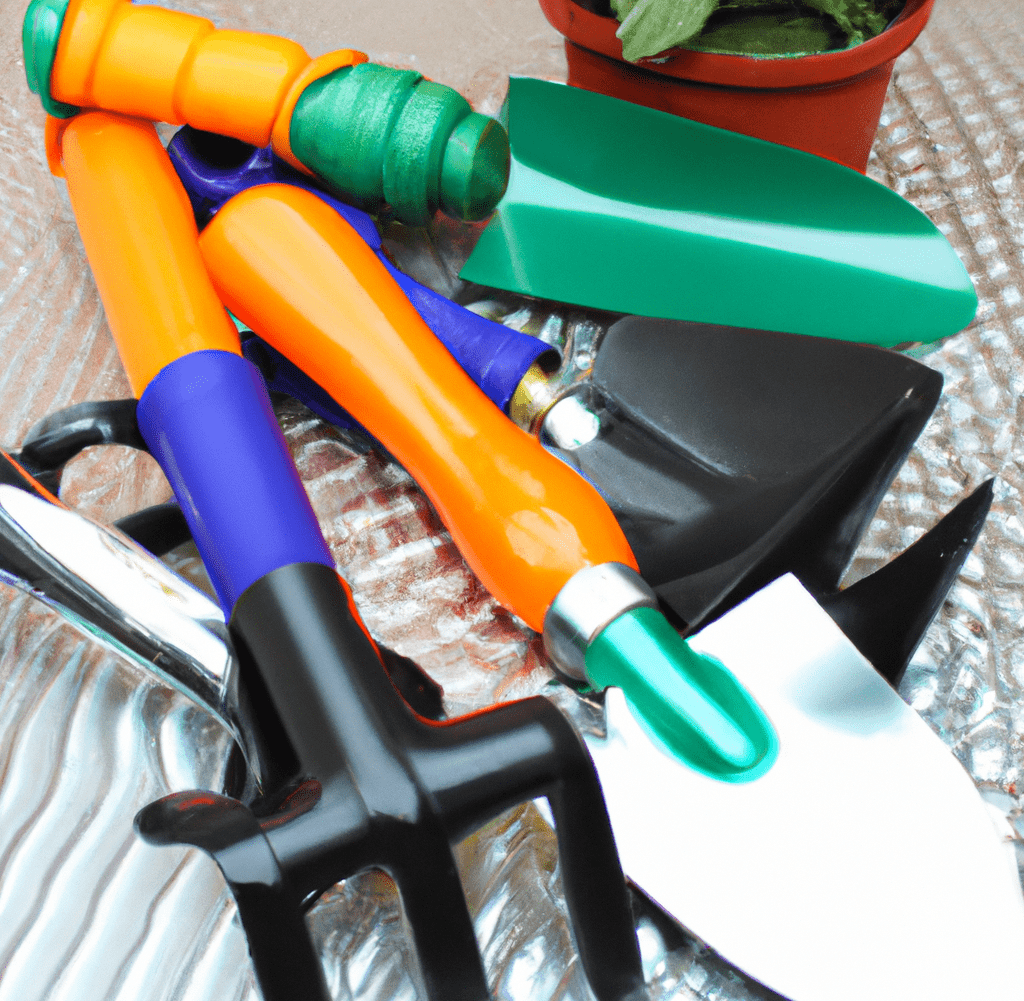
The Different Types of Digging Tasks in Gardening
When you’re thinking about garden tools for specific tasks, you can choose from the following digging tools:
- Hand trowel: A hand trowel is often the ideal equipment for the job when planting little plants. For planting bulbs and young seedlings, a trowel makes it simple and quick to dig a small hole.
- Shovel: A shovel is frequently the finest equipment to use. Shovels can make it simpler to mix in soil additives or build planting beds by moving huge amounts of soil rapidly and effectively.
- Garden fork: A garden fork can be useful when removing plants or weeds from the garden. You may lift and remove plants with a fork without tampering with the soil or leaving behind obstinate clods.
- Spade: A spade can be a helpful tool for forming clean margins around flower beds or walkways. Spades feature a straight blade that makes it simple to cut through soil or grass while leaving behind sharp, defined edges.
It’s crucial to choose digging equipment with high-quality blades composed of resilient materials like stainless steel or tempered carbon steel. Your tools will remain sharp and be able to tackle even the most difficult digging operations as a result. You may easily complete any excavating operation in the yard with the appropriate tools, giving your outdoor space the stunning appearance you’ve always desired.
Types of Digging Tools
In gardening, digging is necessary to work, and having the appropriate tools can make it simpler and more productive. As you learn more about garden tools for specific tasks, take into account the task you will be using the digging equipment for while making your selection. To guarantee that your tools are strong and capable of handling even the most difficult digging operations, look for tools constructed from high-quality materials, such as stainless steel or tempered carbon steel. To make sure the tool is comfortable to use for a prolonged duration, take into account the instrument’s size and weight as well.
Any gardening activity requires the proper digging equipment. You may increase the effectiveness and enjoyment of your gardening work by using the appropriate tools. If you make an investment in good digging equipment, you’ll be able to handle any digging job in the garden with confidence and ease.
How to Choose the Right Digging Tools for Specific Tasks
Now that you know more about garden tools for specific tasks, here’s how to choose the right digging tools:
- Size of the Assignment: The sort of digging tool used will depend on the size of the current task. A trowel is perfect for minor, precise tasks like weeding or transplanting plants. A shovel or a fork might be required for more difficult activities, such as making a garden bed.
- Type of Soil: Various soils call for various tools. It will be necessary to use a strong shovel or fork to break up any hard, compacted soil. A trowel might be adequate if the dirt is loose and simple to work with.
- Control and Comfort: Think about the tool’s weight, size, and grip while choosing a digging tool. Uncomfortable or harmful situations can result from trying to maneuver tools that are overly huge or heavy. To work for long periods of time without becoming tired, look for instruments with a comfortable grip.
- Quality: Long-term time and financial savings are possible when you use high-quality digging gear. A well-made tool with sturdy blades and handles will last longer and function more effectively than a less expensive, inferior substitute.
- Tools for the Job: Some digging jobs call for specific equipment, such as post-hole diggers or edging spades. When utilized properly, these tools, which are made for particular jobs, can save time and effort.
The scale of the task, the type of soil, comfort and control, tool quality, and the requirement for task-specific instruments must all be carefully taken into account when selecting the appropriate digging tool. You’ll be able to finish your gardening activities quickly and easily by taking the time to choose the right tool.
Watering Tools
Every garden needs to water its plants, and using the correct equipment may make the work much simpler and more efficient. Here are the watering tools you can choose from after learning about garden tools for specific tasks:
- Garden hose and sprayer: This essential item is used to water a lot of plants at once. They make it possible to water plants evenly and access plants that are in awkward spots. It is simpler to select a sprayer that meets your needs because they are available in a variety of types, from basic versions to high-pressure nozzles.
- Watering Can: A watering can is a practical instrument for watering individual plants, small regions, or plants in containers. It is simple to regulate the amount of water you pour when using a well-designed watering system, which can deliver a gentle flow of water.
- Drip irrigation: Using a low-pressure watering system called drip irrigation, water is delivered directly to the soil surrounding plants. This technique is excellent for watering numerous plants in a garden bed or big areas. Water can be delivered to plants effectively, and preventing water waste, can aid in water conservation.
- Sprinklers: Using sprinklers to water a significant portion of the garden is another alternative. They are simple to install and can be timed to water your plants even when you are not present. They might not be appropriate in locations with low water pressure or water supply restrictions, though.
Think about things like the size of your garden, the kinds of plants you have, the soil’s quality, and how much water they require when selecting watering tools for your garden. Purchasing high-quality watering equipment can guarantee that your plants get the proper amount of water, preserving their health and growth.
The Different Types of Watering Tasks in Gardening
When learning about garden tools for specific tasks, you’ll need to think about the following to choose the right watering tool:
- Light watering: This method of watering is used for plants, such as seedlings or recently transplanted plants, that need moisture at the soil’s surface. Delivering a small amount of water to the plants with a watering can or gentle sprayer is one option.
- Deep watering: Plants with deep root systems, such as trees and shrubs, are watered using this method. The plants can get the water and nutrients they require since the water is provided right to their roots. For deep watering, drip irrigation or a soaker hose can be helpful.
- Foliar irrigation: Plants that require moisture on their leaves use this method of irrigation. The foliage of the plants can be watered with a fine mist sprayer.
- Watering plants in containers: Because they dry up more quickly than plants in the ground, plants in containers need to be watered more frequently. Water can be delivered to the roots of container plants using a watering can or hose with a particular adapter.
You can make sure that your plants are receiving the appropriate amount of water they require to grow by being aware of the many types of watering activities and the tools that are best suited for each. By using the proper watering equipment and methods, you can maintain healthy plants and save time and effort while also conserving water.
Other Specialty Tools
There are various specialized tools that can help make particular gardening tasks easier and more effective, in addition to the basic tools like trowels, shears, and watering tools. As you look into garden tools for specific tasks, here are specialty tools you can consider:
- Garden knife: A garden knife is a multipurpose instrument that can be used for a variety of tasks, including slicing through stubborn stems and roots, opening bags of soil or fertilizer, and even gathering fruits and vegetables.
- Hand cultivator: A hand cultivator is a small tool with three or four tines that can be used to break up soil clumps, loosen and aerate the soil, and eliminate weeds.
- Soil knife: A soil knife is a multifunctional instrument that can be used for planting, weeding, excavating, and cutting through roots. Typically, it has a serrated edge on one end and a sharp blade on the other.
- Pruning saw: An instrument with a long, curved blade is called a pruning saw, and it is used to prune trees and shrubs. It’s made to sever thicker branches that are difficult to cut with shears or pruners.
- Garden scissors: Garden scissors are tiny, hand-held scissors that are perfect for finely trimming flowers, herbs, and other delicate plants. They may also be harvested and used for deadheading.
- Lawnmowers: If your garden has a lawn, a lawn mower is a necessary piece of equipment. Push mowers, electric mowers, and gas-powered mowers are a few of the several types of lawnmowers. Select the model that best fits the size and topography of your lawn.
- Hedge trimmers: To keep your garden’s bushes and hedges in good shape, you’ll need to invest in a hedge trimmer. Electric and gasoline-powered hedge trimmers are both available. Gas-powered trimmers are more potent and better suited for heavy-duty activities, while electric trimmers are more environmentally friendly and quieter.
- Rakes: Rakes are excellent for clearing away rubbish from your garden, including grass clippings, leaves, and other objects. They are available in different varieties, such as leaf rakes, garden rakes, and grass rakes. Pick the one that best fits the requirements of your garden.
- Wheelbarrows: If you have a sizable yard or garden, a wheelbarrow can come in handy for transporting heavy items like dirt, compost, or gardening equipment. Wheelbarrows exist in a variety of shapes and sizes, including variants with one wheel or two wheels and varying carrying capacities.
You may simplify and improve the efficiency of certain gardening activities by including these specialized tools in your garden equipment. Choose one of these pieces of equipment that will be most helpful to you by taking into account the particular requirements of your plants and garden.
Other Tasks That Require Specific Tools in Gardening
When learning about these particular garden tools for specific tasks, there are instances you’ll need them such as:
- Soil testing: You must conduct soil testing to ascertain the soil’s quality and pH level. You will want a soil test kit for this, which typically comes with a pH and nutrient tester.
- Transplanting: You will need a transplanting tool, such as a hand-held transplanter or a bulb planter, when you want to move seedlings or young plants from one place to another. You may relocate the plants without injuring their roots by using these tools to dig tiny, exact holes in the dirt.
- Grafting: Grafting is a technique for fusing two plants to produce a new hybrid plant. You will want a grafting knife for this task, which has a particular blade made for making accurate incisions in plant stems.
- Amendment of the soil: You will require a tool for incorporating organic materials or fertilizer into the soil. The soil and the amendments can be blended together with a garden fork or a cultivator.
- Harvesting: The tools needed to harvest each type of plant will vary. For instance, to harvest fruits or berries, you will need a set of secateurs or pruning shears, whereas to harvest herbs or flowers, you can use a garden knife or a pair of scissors.
Using the appropriate equipment for particular gardening chores can improve the effectiveness and efficiency of your work. Consider the specific items you will need to complete the work before beginning any new gardening endeavor.
How to Choose the Right Specialty Tools for Specific Tasks
The effectiveness and caliber of your labor can be significantly improved by selecting the appropriate specialized tools for your gardening duties. As you learn about garden tools for specific tasks, choose the right specialty tools after thinking about the following:
- Specific requirements: Think about the particular requirements of your garden and the jobs you need to complete when choosing specialized tools. For instance, a ride-on lawn mower may be more appropriate than a push mower if you have a vast lawn. An electric hedge trimmer might not be as powerful if you have a lot of shrubs or hedges.
- Quality and material: When selecting specialized tools, take into account the tool’s quality and the materials it is composed of.
- Comfort: Consider the weight and comfort of the tool in your hands, and look for instruments with sturdy blades and handles.
- Maintenance: Also take into account how much upkeep the tool will need, such as blade sharpening and component replacement.
- Cost: when choosing specialized instruments, take your budget into account. While buying high-quality tools will ultimately save you money, it’s crucial to strike a balance between affordability and quality.
To choose the best specialized equipment for your gardening needs and budget, compare pricing, read reviews of various brands and models, and conduct brand and model research.
Bottom Line: Garden Tools for Specific Tasks
Having garden tools for specific tasks is important and after you get the essentials, you can look into the benefits of using ergonomic garden tools for example.. Using the incorrect tools can make gardening tedious because each gardening operation calls for unique, purpose-built instruments. A good set of gardening tools will not only last for many years, but they will also improve the success and enjoyment of gardening.
Gardeners can ensure that their plants are healthy, that their soil is maintained, and that their gardening experience is enjoyable by using the appropriate tools for various jobs. Therefore, having the appropriate tools is crucial for creating a successful garden, whether you’re a novice or an expert gardener.
Garden Tools for Specific Tasks FAQs
Why’s having the right gardening tools essential?
The right tools for the job are essential for gardening success. The correct tools can help gardeners do their chores more efficiently and effectively. Different jobs call for different instruments.
What’s pruning?
Using gardening tools like pruning shears or saws, pruning is the act of cutting or trimming certain plant components, such as branches, leaves, or roots. It is carried out to control the size and shape of a plant, promote the development of fruit or blossoms, get rid of dead or diseased wood, and promote healthy growth.
What kinds of pruning tools are available on the market?
Hand pruners, loppers, and shears are a few of the pruning tool varieties available on the market.
How do you pick the best trimming equipment for a given job?
You should take the size of the project, the soil you will be dealing with, and the blade quality into account when selecting the appropriate pruning tools for a certain operation. Additionally, seek pruning tools that are comfortable to use and have good ergonomics.
What are tools for digging?
Digging tools are essential gardening equipment used for soil preparation, planting, and landscaping.
What different gardening watering responsibilities are there?
Light watering, deep watering, foliar irrigation, and watering plants in containers are the four different types of watering tasks in gardening. Each kind needs a particular watering tool.
What other specialized instruments are available for gardening tasks?
Garden knives, hand cultivators, soil knives, pruning saws, garden scissors, lawnmowers, hedge trimmers, rakes, and wheelbarrows are a few additional specialized tools for gardening jobs. Certain gardening tasks can be streamlined and made more effective with the help of this equipment.
What gardening jobs call for particular tools?
Soil testing, transplanting, grafting, amending the soil, and harvesting are some gardening chores that call for particular tools. Each work needs a particular instrument to be completed properly and quickly.


